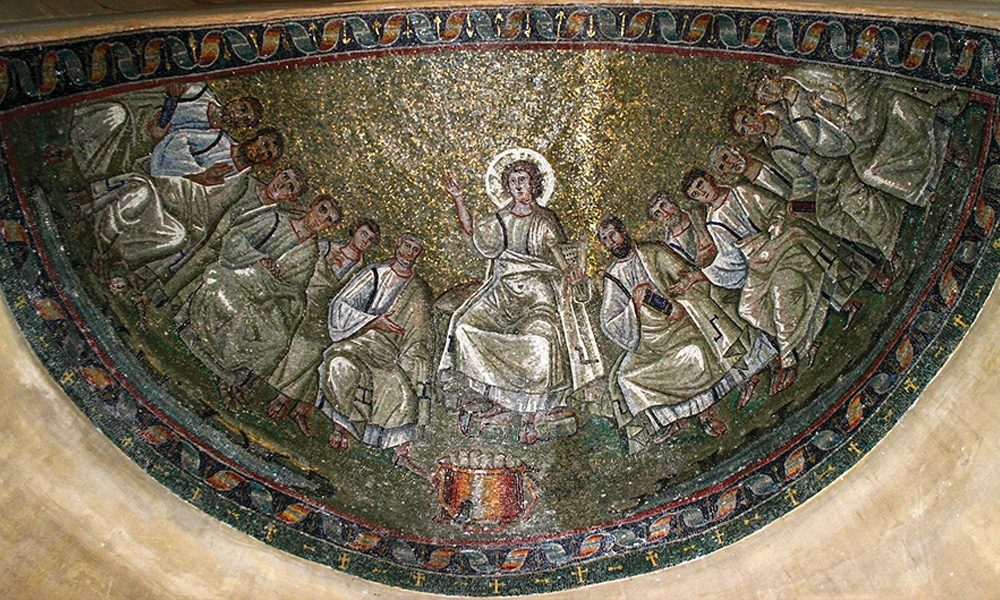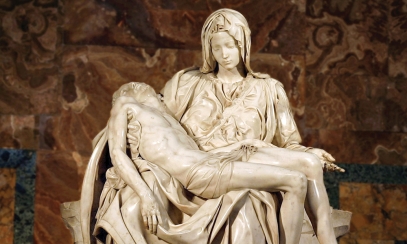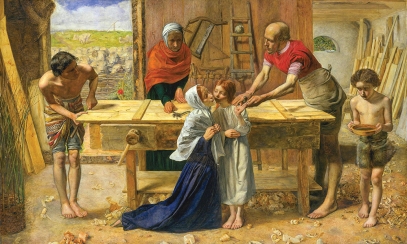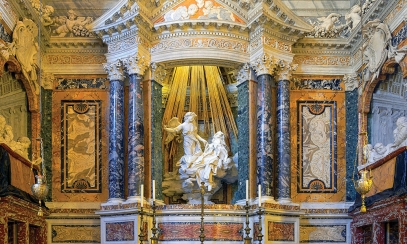
A study of the oldest known icon of Christ Pantocrator
In Catholic iconography, a raised right arm with one or two fingers pointing upward symbolizes either teaching or blessing, depending on the context of the art. In the semicircle mosaic in the Basilica of San Lorenzo in Milan, Jesus is seated with a basket of scrolls at his feet and the apostles seated on each side of him. I think most of us are comfortable with that representation of Jesus as teacher.
In Catholic iconography, a raised right arm with one or two fingers pointing upward symbolizes either teaching or blessing, depending on the context of the art. In the semicircle mosaic in the Basilica of San Lorenzo in Milan, Jesus is seated with a basket of scrolls at his feet and the apostles seated on each side of him. I think most of us are comfortable with that representation of Jesus as teacher.
Now look at the Christ Pantocrator, which is Greek for “ruler of all.” This encaustic (resins and pigments mixed with heat into wax) painting hangs in St. Catherine’s Monastery located at the foot of Mount Horeb (Sinai) in Egypt. A UNESCO World Heritage site, the monastery has been in continuous use since it was founded in the sixth century and is purportedly built on the site of the burning bush, where God spoke to Moses. This icon is the oldest known icon of Christ Pantocrator.
If you study the icon carefully, you will see the left and right sides of Chrit’s face are treated differently. The left side is bathed in light, Christ’s brow is relaxed, his eye is clear, his mouth is neutral, and his hand emerges from under his cloak, open with two fingers pointing upward. The right side of the painting has shadows, Christ’s brow is furrowed, his eye is somewhat darkened, his mustache turns downward, his mouth is shortened, his ear is obscured, his cloak is pulled up on his neck, and he holds an elaborately decorated Bible. So, what are we to make of this image? Is Christ blessing or teaching? Is this a suggestion that Christ is both fully human and fully divine? Is Christ both a loving teacher and fearful judge?
A hint lies in the title “Ruler of All.” As Americans, many of us might chafe at the idea of being ruled. We are in an ego-centric and “rugged individualist” society, and we live in a democracy. On the other hand, we say the “Lord’s Prayer” at every Mass. But have we adopted a false interpretation of the word “Lord” to make us more comfortable? When we say: “Thy kingdom come, thy will be done, on earth as it is in heaven,” who do we think is king? In this painting, the Bible suggests teaching, but what is it teaching? The law, of course, with both the strictures of the Old Testament and the New Covenant commandments stressing love.
This is God’s way of ordering things, and it is a pure gift to us. When we choose to act contrary to Christ’s teachings, we are depriving ourselves of a full relationship with God. Almost 1,500 years ago this artist created a single image of Jesus as brother and Christ as king, suggesting that asking a loving God to rule our lives will grace us with God’s kingdom here and now.
Mark Landers is a parishioner of St. Austin Parish in Austin and a member of the Diocesan Fine Arts Council. He and his wife, Christina, own and operate Landers’ Studio, a woodworking shop and design studio. They design and construct custom furniture and high-quality architectural piecework.



